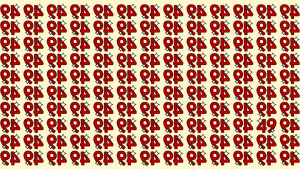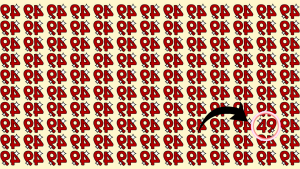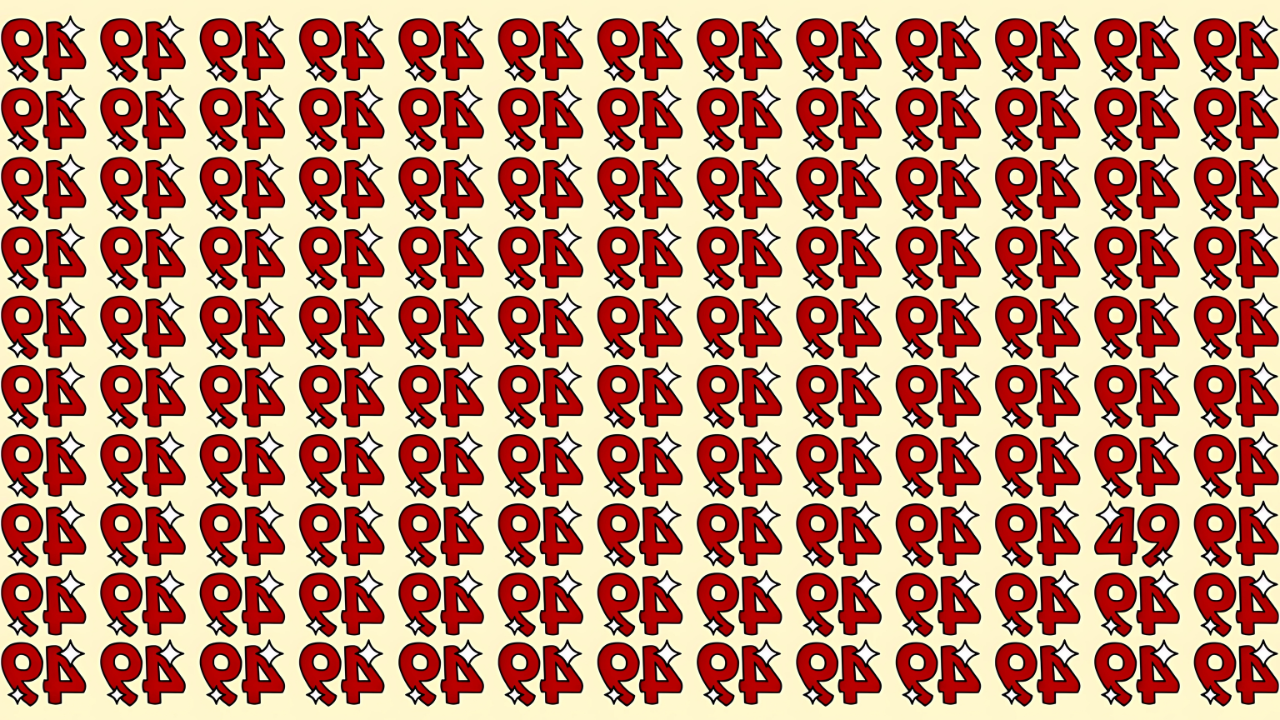The challenge lies not in complexity but in overcoming our brain’s tendency to normalize patterns. This is what makes optical illusions so fascinating and sometimes frustrating! Have you ever stared at something so long your eyes started playing tricks on you? That strange moment when patterns begin to swim and shapes seem to move isn’t just your imagination going wild. It’s actually your clever brain processing visual information in fascinating and sometimes confusing ways.
Today I want to share a particularly tricky challenge that’s been making rounds on social media lately. It might look simple at first glance, but trust me, it’s left countless people scratching their heads in total bewilderment.
What Makes This Challenge So Incredibly Difficult?
The task itself sounds straightforward enough – find one correctly oriented number 49 hiding among dozens of inverted 49s. Oh, and you’ve only got 9 seconds to do it! Sounds impossible, right?
Your brain processes a staggering 11 million bits of information every second through your senses. Yet remarkably, you’re only consciously aware of about 50 bits at any given moment.
This filtering system usually helps us navigate daily life efficiently. Unfortunately, it works against us during perception challenges like this particular optical illusion.
Optical Illusion Challenge

The Science Behind How Your Eyes Deceive You
When you first look at the image filled with red 49s, they all start to look identical after just a few seconds. This isn’t you being careless – it’s actually your brain trying to be efficient!
The inverted numbers create a pattern your mind quickly accepts as normal. The correctly oriented 49 blends in seamlessly unless you’re actively searching for subtle differences.
Many people glance right past the correct number several times before finally spotting it. I know I did when I first tried this challenge!
Why Time Pressure Makes Everything Harder
Adding that 9-second countdown isn’t just for extra excitement – it fundamentally changes how your brain approaches the task. Under time pressure, we tend to scan more quickly but less thoroughly.
When the clock is ticking, your amygdala triggers a mild stress response. This reaction helped our ancestors make split-second decisions in dangerous situations but actually hinders performance in tasks requiring careful attention.
“The timing element transforms this from a simple visual puzzle into a test of how efficiently your brain processes information under pressure,” explains Dr. James Wilson, who specializes in visual perception research.
Pattern Recognition: Blessing and Curse
Our visual cortex evolved to be remarkably good at pattern recognition. This adaptation helped our ancestors quickly spot predators hiding in tall grass or identify nutritious berries among leaves.
This same ability creates a blind spot during certain optical illusions. When surrounded by dozens of inverted 49s, your brain categorizes everything as “same” until you consciously override this automatic sorting.
The longer you stare at the image, the more your brain adapts to seeing the inverted 49s as normal. This makes finding the correctly oriented one increasingly difficult over time.
Optical Illusion Answer

The Psychology of Puzzle Solving
Despite the frustration these challenges sometimes cause, millions of people actively seek them out. This seemingly contradictory behavior makes perfect sense when you understand the psychology behind it.
Successfully solving a tricky puzzle triggers a delightful dopamine release in your brain. This creates a natural high similar to the satisfaction of completing any challenging task.
That brief “aha!” moment when you finally spot the correct 49 delivers a concentrated burst of accomplishment. This feeling keeps people coming back for more puzzles and sharing them with friends.
Social media has transformed these once-solitary brain teasers into shared experiences. Commenting “found it!” or challenging friends amplifies the satisfaction through social validation.
Improving Your Visual Detection Skills
Not everyone spots the correct 49 within the time limit, and that’s perfectly okay! These abilities improve significantly with regular practice and a few helpful techniques.
Try working methodically from one corner to another instead of randomly searching the image. This prevents repeatedly checking the same areas while missing others completely.
You can also practice expanding your peripheral vision by focusing on a central point while trying to notice details at the edges of your visual field. This skill transfers to many real-world situations.
Perhaps most importantly, try looking for what breaks the pattern rather than what fits it. In this specific challenge, focus on finding what looks “wrong” compared to everything else.
Real-World Applications Beyond Entertainment
While these challenges are undeniably entertaining, they exercise cognitive abilities used in numerous professional fields and everyday situations. They’re not just games!
Medical professionals rely on similar pattern recognition when examining complex scans. Radiologists must spot subtle differences that could indicate serious health conditions.
Security personnel at airports must quickly identify unusual objects among thousands of normal ones – essentially the same skill as finding the correctly oriented 49 in our challenge.
Even everyday activities like driving benefit from strong visual processing. Spotting potential hazards quickly can prevent accidents in situations where split-second decisions truly matter.
The Solution Revealed
If you’re still searching for the elusive correct 49, I’ll help you out. The properly oriented number appears in the bottom right section of the image.
While most 49s in the picture are displayed upside-down, this single correct one stands right-side up. The difference is subtle – the inverted 49s have their curves and angles flipped in the opposite direction.
Don’t feel discouraged if you didn’t spot it within 9 seconds. Many people need several attempts before finding it successfully.
Creating Your Own Visual Challenges
Enjoyed this puzzle? Why not create similar challenges for friends and family? These homemade brain teasers make excellent activities for family game nights or team-building exercises.
Start with simple patterns and gradually increase complexity as you get more creative. The key is creating something with a single “different” element that blends convincingly with numerous similar items.
Digital tools make creation easy, but even hand-drawn puzzles work remarkably well. The satisfaction comes from both creating and solving these visual mysteries.
Why We Love Being Fooled
Our fascination with optical illusions reveals something fundamental about human nature – we’re naturally driven to solve puzzles, detect patterns, and test our perceptual limits.
Each time we engage with these visual challenges, we learn something new about how our minds work. There’s a childlike wonder in discovering how easily our sophisticated brains can be tricked.
Perhaps most importantly, these puzzles remind us to question what we see. In a world where visual information bombards us constantly, developing critical observation skills becomes increasingly valuable.
Next time you encounter a visual brain teaser like the 49 challenge, remember: it’s more than just entertainment. It’s exercise for one of your most remarkable biological systems – that incredible pattern-detecting machine between your ears!
So, did you spot the correct 49 within 9 seconds? Whether you succeeded or not, your brain got a healthy workout just by trying!
FAQs About Optical Illusions
How do optical illusions help brain development? Engaging with visual puzzles stimulates neural pathways involved in processing, potentially improving cognitive flexibility and attention to detail over time.
Why do some people solve these puzzles faster than others? Individual differences in visual processing speed, pattern recognition abilities, and prior experience with similar challenges all contribute to solving speed variations.
Can practicing these puzzles improve everyday observation skills? Yes, regular engagement with visual puzzles can enhance attention to detail and pattern recognition that transfers to real-world tasks like driving or noticing important details.
Are children better at solving optical illusions than adults? Not necessarily. While children sometimes approach puzzles with fewer preconceptions, adults often have more developed systematic searching strategies.
Why do we enjoy optical illusions despite the frustration they cause? The dopamine release upon solving a challenging puzzle creates a reward response that outweighs the temporary frustration experienced during the search.
Do these visual processing skills decline with age? Some aspects of visual processing speed may decrease with age, but experience and practiced strategies often effectively compensate for these natural changes.
How long should it take to solve most optical illusions? There’s no standard time – puzzles vary widely in difficulty. The time limits (like 9 seconds) are often arbitrary challenges to increase excitement.
Can optical illusions cause headaches or eye strain? Prolonged viewing of certain patterns might cause temporary visual discomfort in some people, but taking breaks prevents most issues.
What’s the difference between optical illusions and visual puzzles? Optical illusions specifically trick your visual perception system, while visual puzzles may include other elements like logic or mathematical components.
Can creating optical illusions be educational? Absolutely! Designing illusions requires understanding principles of visual perception, geometry, and psychology – making it an excellent learning activity.
